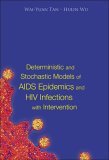 |
Deterministic and Stochastic Models of AIDS Epidemics and HIV Infections with InterventionBy Wai-Yuan Tan and Hulin Wu |
Preface
Contents
Order Book <http://www.worldscibooks.com/medsci/5737.html>
Preface
It is well recognized that AIDS is the most dangerous disease in the 21st century threatening the survival of human beings. It has been estimated by WHO (World Health Organization) that by 2003 there are at least 40 million people world-wide who are currently living with HIV/AIDS; at least 3 million people have died of AIDS and 5 million people have acquired HIV in 2003. From these statistics, obviously the most urgent challenging task is how to control HIV epidemics. Because of the complexity and seriousness of the disease, for understanding AIDS epidemics and HIV pathogenesis and for developing efficient strategies for controlling AIDS, mathematical models that take into account the dynamics of HIV epidemics and the biology of HIV pathogenesis are definitely needed. With this in mind, many mathematical models for AIDS epidemics and for HIV pathogenesis have been developed. These models have been summarized in books by Tan (2000) and in Mode and Sleeman (2000). However, few papers and models deal with drug treatments and AIDS vaccines. To fill this gap, the goal of this book is to solicit papers from world experts on HIV/AIDS treatment and vaccines. This derives basically from the following two observations:
(1) In the past ten years, important breakthroughs have been achieved in treating HIV-infected patients through the combination of Nucleoside Reverse Transcriptase Inhibitor (NRTI) drugs such as AZT and DDI with Protease Inhibitor (PI) drugs such as ritonavir and nelfinavir or Non-nucloside Reverse Transcriptase Inhibitor (NNRTI) drugs such as efavirenz, referred to as the Highly Active Anti-Retroviral Therapy (HAART). However, it is far from cure. For developing optimal treatment regimens, there are also serious problems that remain to be addressed; furthermore, to successfully control the level of HIV, life-long HAART treatments are often required. In this book we will solicit papers from world experts to present an over view on the latest advances in this aspect.
(2) Because AIDS is not curable, the best and cost-effective strategy is by prevention via AIDS vaccination. In this book we will solicit papers from world experts to provide a most recent review on the status of AIDS vaccination and newly developed models for AIDS vaccines.
Because the HIV epidemic via IV drug becomes more important and is the major avenues for AIDS in China and Asia and because very few models in the past dealt with IV drug use, in this book we will also include some papers to present an updated review on HIV/AIDS via IV drug use. Because in Cuba every one in the country has been surveyed and under surveillance, we will also present a paper by Hsieh et al. to illustrate the effect of complete surveillance on AIDS epidemics.
This book contains 23 chapters and is organized into the following 6 parts:
- Part I: AIDS Epidemic Models
- Part II: HIV Vaccine Models
- Part III: Models for HIV/Cell Dynamics and Interactions
- Part IV: Viral Dynamics Under Antiviral Treatments
- Part V: Modeling Drug Resistance
- Part VI: Statistical Methods.
In Part I, extensive deterministic models, stochastic models, state space models and statistical methods as well as statistical methods for HIV epidemics involving IV drug use and HIV epidemics in homosexual populations are reviewed and discussed. In Part II, the book presents a review on the latest mathematical models for assessing effects of AIDS vaccines and provides statistical methods for analyzing clinical trial data on AIDS vaccines. In Part III, the book provides most recent biological insights into HIV pathogenesis and HIV kinetics at the cellular level and illustrates how to build up mathematical models based on these biological insights. In Part IV, extensive deterministic models, stochastic models, state space models and statistical methods on treating AIDS patients with anti-retroviral drugs and the pros and cons of these models are presented. For the first time it gives in-depth analysis of HAART treatment regimens and discusses possible improvement of the HAART treatments. It also provides a linkage between pharmacokinetics and treatment in HIV-infected individuals. In Part V, it discusses models and statistical methods for assessing drug resistance of HIV to anti-retroviral drugs. Finally in Part VI, the book provides some important statistical methods specific for the intervention and prevention of HIV epidemics.
In this book, we have solicited papers from world experts on models of AIDS epidemics and HIV pathogenesis under intervention. The topics include deterministic models, stochastic models, state space models and statistical methods for antiviral treatment and AIDS vaccines. It provides the latest information in this field. It will be a useful reference source for graduate students and researchers in biomathematics and biostatistics, as well as for HIV/AIDS epidemiologists and clinical investigators learning how to use quantitative methods to study AIDS epidemics and HIV infection.
We would like to express our sincere appreciation to all contributors who have made this book possible. We also wish to thank Dr. Sook Cheng Lim of World Scientific Publication Company for assistance in the publication of this book.
